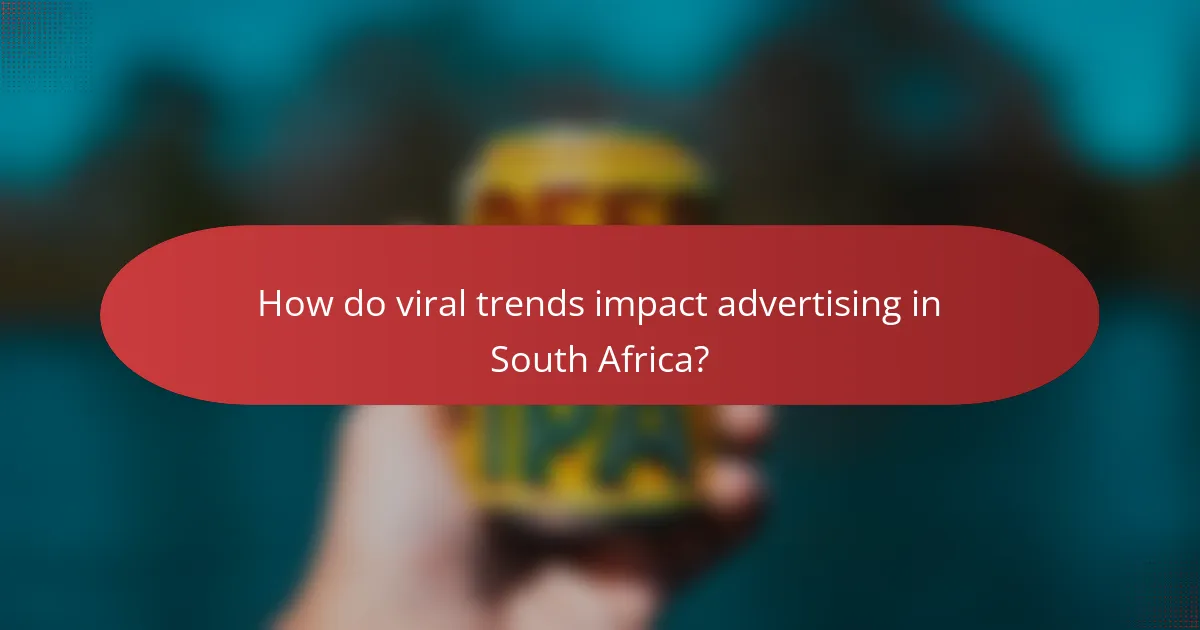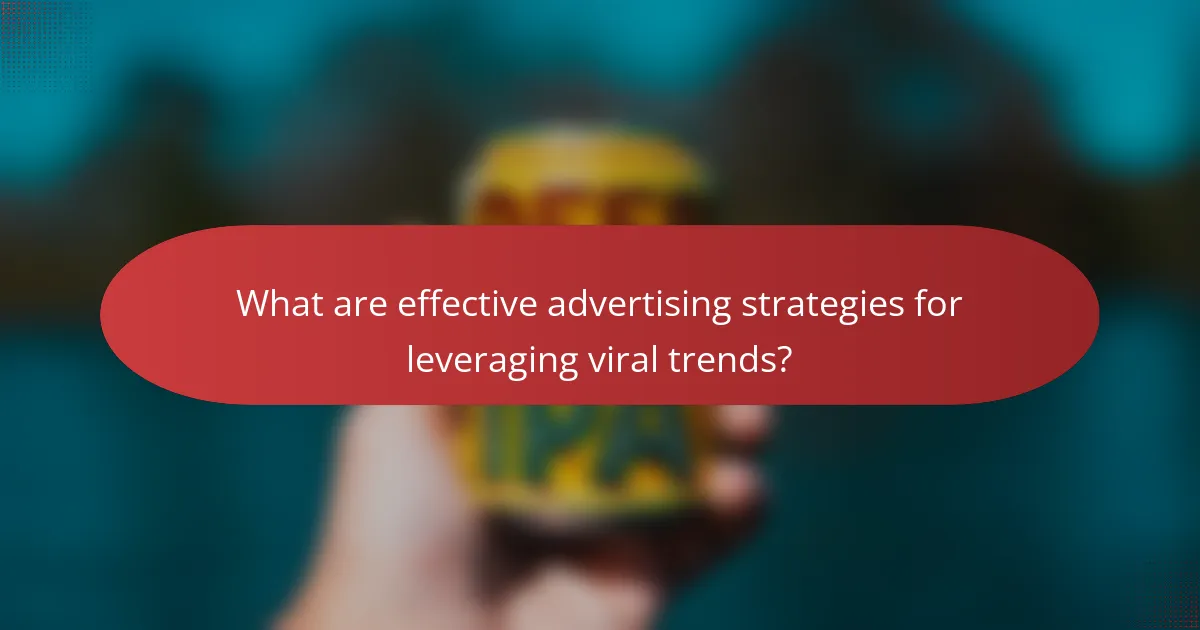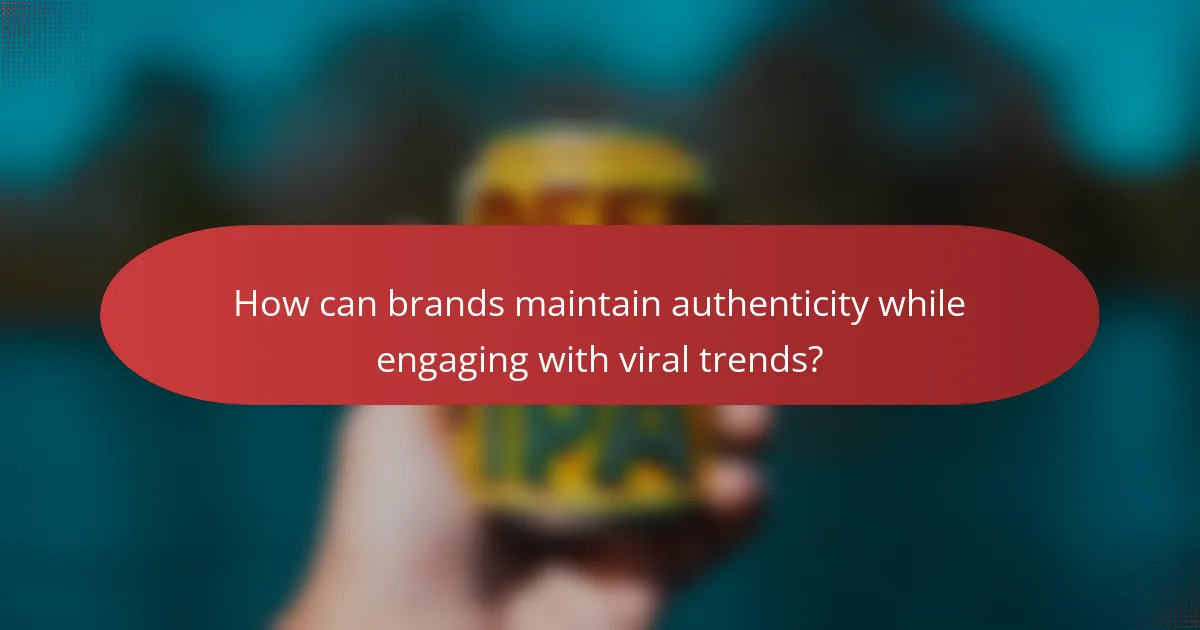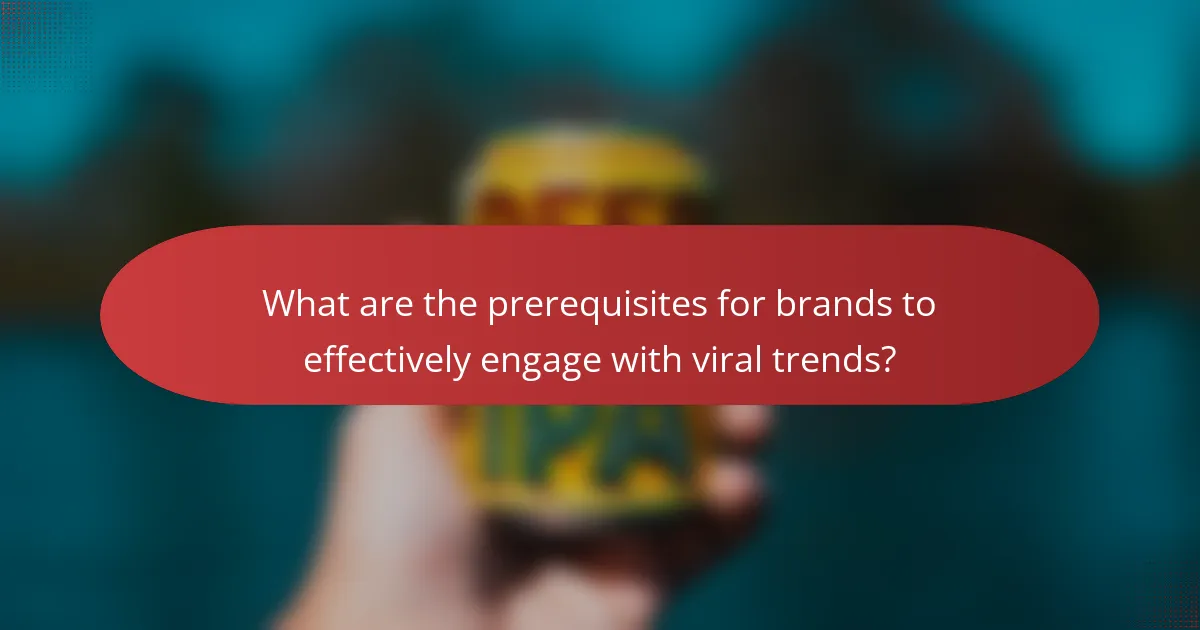Viral trends play a crucial role in shaping advertising strategies, particularly in South Africa, where they enhance brand visibility and foster consumer engagement. To effectively leverage these trends, advertisers must focus on timely engagement and authentic messaging, ensuring that their campaigns resonate with local audiences. By integrating social media influencers and creating shareable content, brands can capitalize on the momentum of viral trends while maintaining their core values and identity.

How do viral trends impact advertising in South Africa?
Viral trends significantly influence advertising in South Africa by enhancing brand visibility and consumer engagement. Advertisers must adapt their strategies to leverage these trends effectively, ensuring they resonate with local audiences and cultural nuances.
Increased brand visibility
Viral trends can dramatically boost brand visibility, often leading to exponential reach within a short time frame. For instance, a brand that aligns itself with a trending meme or challenge can see its social media impressions soar into the millions.
To capitalize on this, brands should monitor social media platforms for emerging trends and act quickly. Engaging with popular content can place a brand at the forefront of consumer conversations, increasing recognition and recall.
Enhanced consumer engagement
When brands participate in viral trends, they often experience heightened consumer engagement. This engagement can manifest as increased likes, shares, and comments on social media, fostering a sense of community around the brand.
Brands should encourage user-generated content related to the trend, as this can amplify engagement further. For example, running contests or challenges that invite consumers to create their own content can deepen their connection to the brand.
Shift in marketing strategies
The rise of viral trends necessitates a shift in marketing strategies for brands operating in South Africa. Traditional advertising methods may become less effective as consumers gravitate towards authentic, relatable content that reflects current trends.
Marketers should adopt a more agile approach, allowing them to pivot quickly in response to viral phenomena. This might involve reallocating budgets to digital platforms that facilitate real-time engagement and content creation, ensuring that advertising remains relevant and impactful.

What are effective advertising strategies for leveraging viral trends?
Effective advertising strategies for leveraging viral trends focus on timely engagement and authentic messaging. Brands can capitalize on these trends by using social media influencers, creating shareable content, and implementing real-time marketing tactics.
Utilizing social media influencers
Partnering with social media influencers can significantly amplify your brand’s reach during viral trends. Influencers have established trust with their followers, making their endorsements more impactful than traditional advertising.
When selecting influencers, consider their audience demographics and engagement rates. Aim for micro-influencers who often have higher engagement levels and more niche audiences, which can lead to better conversion rates.
Creating shareable content
Shareable content is key to capitalizing on viral trends. This type of content is typically entertaining, informative, or emotionally resonant, prompting users to share it with their networks.
To create shareable content, focus on visual elements like videos and infographics, as these formats tend to perform well across platforms. Use catchy headlines and relatable themes to increase the likelihood of shares.
Real-time marketing tactics
Real-time marketing involves responding to current events or trends as they unfold. This strategy requires agility and a keen understanding of the social media landscape to effectively engage audiences at the right moment.
Monitor trending topics and hashtags closely, and be prepared to create relevant content quickly. However, ensure that your messaging aligns with your brand values to maintain authenticity and avoid backlash.

How can brands maintain authenticity while engaging with viral trends?
Brands can maintain authenticity while engaging with viral trends by ensuring their actions align with core values and resonate genuinely with their audience. This involves thoughtful integration of trends into marketing strategies without compromising brand identity.
Aligning with brand values
To stay authentic, brands must align their engagement with viral trends to their established values. This means evaluating whether a trend reflects the brand’s mission and ethics. For example, a sustainable brand should avoid promoting trends that contradict its environmental commitments.
Brands can create a checklist to assess alignment, asking questions like: Does this trend resonate with our target audience? Does it reflect our core values? If the answers are negative, it’s best to reconsider participation.
Transparent communication
Transparent communication is crucial for maintaining authenticity. Brands should openly share their motivations for engaging with a trend, explaining how it fits into their overall strategy. This builds trust with consumers who appreciate honesty.
For instance, if a brand partners with a viral influencer, it should disclose the nature of the partnership and any compensation involved. This transparency fosters a sense of integrity and can enhance consumer loyalty.
Consistent messaging
Consistency in messaging is vital when engaging with viral trends. Brands should ensure that their communications reflect the same tone, style, and values across all platforms. This prevents mixed messages that could confuse or alienate audiences.
To achieve consistency, brands can develop a style guide that outlines key messaging points and tone. Regular training for marketing teams can also help maintain this uniformity, ensuring that all promotional materials align with the brand’s identity.

What metrics should brands track to measure the impact of viral trends?
Brands should focus on engagement rates, conversion rates, and brand sentiment analysis to effectively measure the impact of viral trends. These metrics provide insights into how audiences interact with content, how well it translates into sales, and the overall perception of the brand in the market.
Engagement rates
Engagement rates reflect how actively users interact with content, including likes, shares, comments, and views. High engagement indicates that the content resonates with the audience, which is crucial for leveraging viral trends. Brands should aim for engagement rates in the range of 1-5% for social media posts, though this can vary by platform.
To track engagement, brands can use tools like social media analytics or website tracking software. Monitoring engagement helps identify which content types are most effective and can guide future marketing strategies.
Conversion rates
Conversion rates measure the percentage of users who take a desired action, such as making a purchase or signing up for a newsletter, after engaging with viral content. A strong conversion rate indicates that the viral trend successfully drove users to act. Brands typically see conversion rates between 2-10% depending on the industry and the effectiveness of the call-to-action.
To improve conversion rates, brands should ensure that their landing pages are optimized for user experience and clearly communicate the value proposition. A/B testing different approaches can also help identify the most effective strategies.
Brand sentiment analysis
Brand sentiment analysis gauges public perception of a brand, often through social listening tools that analyze comments and mentions across various platforms. Positive sentiment can amplify the effects of a viral trend, while negative sentiment can hinder brand reputation. Brands should regularly assess sentiment to understand how viral trends impact their image.
To conduct sentiment analysis, brands can use tools like Brandwatch or Hootsuite, which categorize mentions as positive, negative, or neutral. Monitoring sentiment trends over time can help brands respond proactively to public perception shifts and adjust their marketing strategies accordingly.

What are the prerequisites for brands to effectively engage with viral trends?
Brands need a deep understanding of their target audience, a robust monitoring system for social media platforms, and a flexible marketing plan to effectively engage with viral trends. These elements ensure that brands can respond swiftly and authentically to trends that resonate with their consumers.
Understanding target audience
To engage with viral trends, brands must first understand their target audience’s preferences, behaviors, and values. This involves researching demographics, psychographics, and online habits to tailor content that resonates with them. For example, a brand targeting Gen Z might focus on platforms like TikTok, while one appealing to older audiences may prioritize Facebook.
Utilizing surveys, social listening tools, and analytics can provide insights into what content types and themes are most engaging. Brands should also consider cultural nuances and current events that may influence audience sentiment.
Monitoring social media platforms
Effective monitoring of social media platforms is crucial for identifying emerging trends. Brands should use tools that track keywords, hashtags, and mentions related to their industry and audience. This allows them to spot trends early and gauge public sentiment.
Regularly checking platforms like Twitter, Instagram, and TikTok can help brands stay ahead of the curve. Setting up alerts for specific keywords can also ensure timely responses to relevant trends, preventing missed opportunities.
Developing a flexible marketing plan
A flexible marketing plan is essential for brands to adapt quickly to viral trends. This plan should include predefined strategies for content creation, distribution, and engagement that can be adjusted based on real-time insights. For instance, if a trend emerges that aligns with a brand’s values, they should be ready to pivot their messaging accordingly.
Brands should also allocate resources for rapid content production, ensuring they can create and share relevant materials without delays. Regularly reviewing and updating the marketing plan based on performance metrics can help maintain alignment with audience interests and trending topics.

What are some case studies of successful viral trend campaigns in South Africa?
Successful viral trend campaigns in South Africa often leverage local culture, humor, and social media engagement to resonate with audiences. Notable examples demonstrate how brands can effectively tap into current trends to enhance visibility and drive consumer interaction.
Case Study 1: The #ImStaying Movement
The #ImStaying campaign emerged as a grassroots movement on social media, encouraging South Africans to express their commitment to the country despite challenges. Brands like FNB and Vodacom joined the conversation, aligning their messaging with the movement’s positive sentiment.
This campaign showcased the power of authenticity, as companies that genuinely supported the cause saw increased engagement and loyalty from consumers. The key takeaway is that aligning brand values with social movements can create a strong emotional connection.
Case Study 2: Nando’s #NandosForAll
Nando’s launched the #NandosForAll campaign to promote inclusivity and celebrate diversity in South Africa. The campaign utilized humor and relatable content, resonating with a broad audience while reinforcing the brand’s identity.
By engaging with current social issues through a light-hearted approach, Nando’s successfully generated buzz and conversation online. Brands should consider using humor and relatability to connect with their audience while addressing relevant social themes.
Case Study 3: Castle Lager’s #CastleLagerChallenge
Castle Lager initiated the #CastleLagerChallenge, encouraging fans to share their best moments while enjoying the product. This user-generated content campaign effectively engaged consumers and amplified brand visibility across social media platforms.
The challenge not only increased brand interaction but also fostered a sense of community among consumers. Brands should explore user-generated content as a strategy to enhance engagement and create a sense of belonging among their audience.


